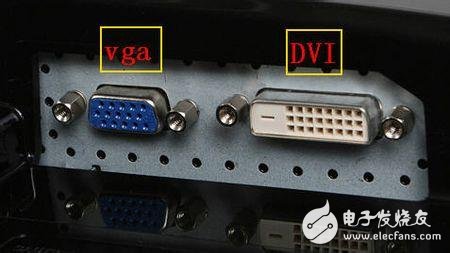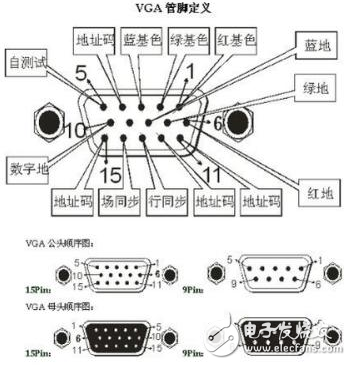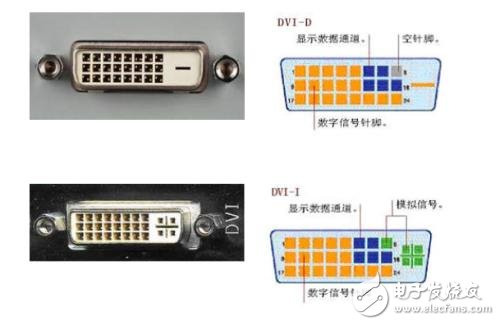The VGA interface and the DVI interface are two common interfaces on the display. What do they do? What are the differences between them? Which is better?


VGA (VideoGraphicsArray) video graphics array is a computer display standard that IBM proposed in 1987 using analog signals. The VGA interface is a dedicated interface for the computer to use VGA standard output data. The VGA interface has a total of 15 pins, divided into 3 rows, 5 holes per row, and the most widely used interface type on the graphics card. Most graphics cards have such interfaces. It transmits red, green, and blue analog signals as well as synchronization signals (horizontal and vertical signals).
VGA is a video interface with a pin count of 15, three rows of holes, five per row, mainly used for old-fashioned computer output, which is the specification for the early launch of Zui in three interfaces.
The VGA output and the transmitted analog signal. Everyone knows that computer graphics cards produce digital signals, and displays use digital signals. So using a VGA video interface is equivalent to undergoing a digital-to-analog conversion and a single-modulo conversion. Signal loss, the display is more blurred.
DVI interface definition
DVI (DigitalVisualInterface), which is a digital video interface. It was the interface standard introduced by DDWG (Digital Display Working Group) in 1999 by SiliconImage, Intel (Intel), Compaq (Compaq), IBM, HP (HP), NEC, Fujitsu (Fujitsu) and other companies.
The DVI interface transmits digital signals that can transmit large resolution video signals. DVI is connected to the computer graphics card and display without conversion, so there is no loss of signal.
DVI is based on TMDS (TransiTIonMinimizedDifferentTIalSignaling), which converts the minimum differential signal technology to transmit digital signals. TMDS uses advanced coding algorithms to encode 8-bit data (each of the primary color signals in R, G, and B) into 10-bit data by minimum conversion (including lines). Field synchronization information, clock information, data DE, error correction, etc., after DC balance, using differential signal transmission data, it has better electromagnetic compatibility than LVDS, TTL, can be realized with low-cost dedicated cable Distance, high quality digital signal transmission. The connection transmission structure of TMDS technology is shown in Figure 1. Digital Video Interface (DVI) is an internationally open interface standard that is used in a wide range of applications including PCs, DVDs, HDTVs, and high-definition projectors.
The main difference between VGA interface and DVI interface
1, VGA interface appearance 15 pin, DVI interface appearance is a 24-pin connector;
2. The VGA interface transmits analog signals, and the DVI interface transmits digital signals;
3, VGA interface transmission to the display to undergo a digital-to-analog conversion and a single analog-to-digital conversion, signal loss, display is more fuzzy, and DVI connected to the computer graphics card and display without conversion, no loss of signal;
4, VGA interface transmission because it has to undergo two signal conversion, the speed is slow, the transmission is not stable, and DVI transmission does not require signal conversion, the speed is faster, the transmission is more stable;
5, VGA interface in the 800 & TImes; 600 resolution and DVI interface display effect is almost no difference, but the general analog signal in the case of more than 1280&TImes; 1024 resolution or more will appear obvious error, the higher the resolution is more serious.
to sum upVGA is the most commonly used video input and output interface, carrying analog signals, DVI is a popular high-definition input and output interface, carrying digital signals.
After the above comparison, DVI is more advanced than VGA. Because the digital signal is transmitted, the stability during transmission is good, and the deviation of color, brightness and contrast does not occur. The display of VGA interface is prone to color cast after long-term use. Image correction is often used. DVI supports higher resolution than VGA. DVI is more competitive than VGA in today's ever-increasing traffic.
The Cutting Machine is a product developed for Cutting TPU Protective Films, Hydrogel Screen Protective Films and PVC Back Stickers.
Advantages of Cutting Machine:
1. "0" inventory, no need to worry about large inventory.
2. Compatible with "99%" 20000+ mobile phones, watches, tablets, etc.
3. According to needs-customize the Protective Film that customers want at any time.
4. Will not lose sales opportunities due to shortages.
5. Save product packaging and transportation costs.
6. Say goodbye to the losses caused by unsold old inventory.
7. No need to spend time and energy to find various types of products.
8. Selling new products for the first time.
9. Different styles of Protective Film can be customized.
10. Simple operation, align and paste it on the device, just one step.
11. Green environmental protection, reduce packaging, reduce waste and reduce costs.
12. To meet the needs of more customers.
13. Add value and increase sales for mobile phone stores, offline stores, and value-added services.
14. Exclusive policy, regional guarantee, first come first served.
15. Lead opponents, lead the market, and seize opportunities.
16. Regain retail market share and create higher value space.
17. New generation mobile internet Mobile Phone Protective Film customization system.
18. Quickly start the business model and start the retail business easily.
Hydrogel Cutting Machine, Mobile Phone Screen Protector Cutting Machine, Hydrogel Film Cutting Machine, Hydrogel Protective Film Cutting Machine, Hydrogel Machine
Shenzhen Jianjiantong Technology Co., Ltd. , https://www.jjthydrogelprotector.com